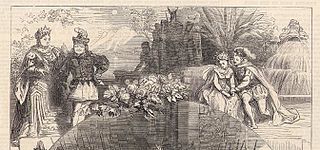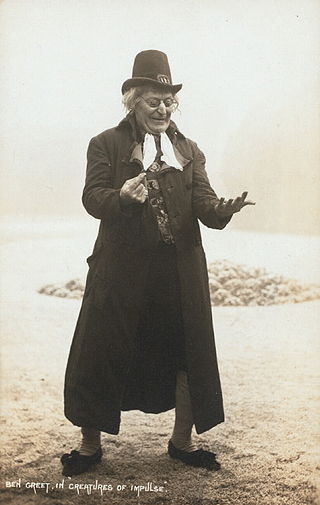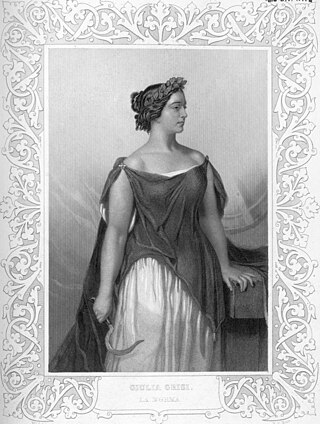
Gilbert and Sullivan refers to the Victorian-era theatrical partnership of the dramatist W. S. Gilbert (1836–1911) and the composer Arthur Sullivan (1842–1900) and to the works they jointly created. The two men collaborated on fourteen comic operas between 1871 and 1896, of which H.M.S. Pinafore, The Pirates of Penzance and The Mikado are among the best known.

Blank verse is poetry written with regular metrical but unrhymed lines. It has been described as "probably the most common and influential form that English poetry has taken since the 16th century", and Paul Fussell has estimated that "about three quarters of all English poetry is in blank verse".

Utopia, Limited; or, The Flowers of Progress, is a Savoy opera, with music by Arthur Sullivan and libretto by W. S. Gilbert. It was the second-to-last of Gilbert and Sullivan's fourteen collaborations, premiering on 7 October 1893 for a run of 245 performances. It did not achieve the success of most of their earlier productions.

Princess Ida; or, Castle Adamant is a comic opera with music by Arthur Sullivan and libretto by W. S. Gilbert. It was their eighth operatic collaboration of fourteen. Princess Ida opened at the Savoy Theatre on 5 January 1884, for a run of 246 performances. The piece concerns a princess who founds a women's university and teaches that women are superior to men and should rule in their stead. The prince to whom she had been married in infancy sneaks into the university, together with two friends, with the aim of collecting his bride. They disguise themselves as women students, but are discovered, and all soon face a literal war between the sexes.
Fallen Fairies; or, The Wicked World, is a two-act comic opera, with a libretto by W. S. Gilbert and music by Edward German. The story is an operatic adaptation of Gilbert's 1873 blank-verse fairy comedy, The Wicked World. In Fairyland, the fairies are curious about wicked mortals, especially their strange capacity for love. They summon three mortal men from the world below to observe them and to teach the men how to live virtuously. The fairies fall in love with the mortals, become jealous of each other and behave badly. The men return to Earth, and the fairies realize that love is overrated.

The Palace of Truth is a three-act blank verse "Fairy Comedy" by W. S. Gilbert first produced at the Haymarket Theatre in London on 19 November 1870, adapted in significant part from Madame de Genlis's fairy story, Le Palais de Vérite. The play ran for approximately 140 performances and then toured the British provinces and enjoyed various revivals even well into the 20th century. There was also a New York production in 1910.
This is a selected list of W. S. Gilbert's works, including all that have their own Wikipedia articles. For a complete list of Gilbert's dramatic works, see List of W. S. Gilbert dramatic works.

Our Island Home is a one-act musical entertainment with a libretto by W. S. Gilbert and music by Thomas German Reed that premiered on 20 June 1870 at the Royal Gallery of Illustration. The piece has five characters and is "biographical", in that the characters in the original production played themselves, except that they were given personalities opposite to their actual personalities.
Broken Hearts is a blank verse play by W. S. Gilbert in three acts styled "An entirely original fairy play". It opened at the Royal Court Theatre in London on 9 December 1875, running for three months, and toured the provinces in 1876. It was revived at the Savoy Theatre in 1882. Julia Gwynne played Melthusine. It was revived again in 1883, and yet again in 1888 starring Marion Terry in February and Julia Neilson in May, and also at Crystal Palace that year. There was also a New York City production at the Madison Square Theatre.

Sir William Schwenck Gilbert was an English dramatist, librettist, poet and illustrator best known for his collaboration with composer Arthur Sullivan, which produced fourteen comic operas. The most famous of these include H.M.S. Pinafore, The Pirates of Penzance and one of the most frequently performed works in the history of musical theatre, The Mikado. The popularity of these works was supported for over a century by year-round performances of them, in Britain and abroad, by the repertory company that Gilbert, Sullivan and their producer Richard D'Oyly Carte founded, the D'Oyly Carte Opera Company. These Savoy operas are still frequently performed in the English-speaking world and beyond.

The Wicked World is a blank verse play by W. S. Gilbert in three acts. It opened at the Haymarket Theatre on 4 January 1873 and ran for a successful 145 performances, closing on 21 June 1873. The play is an allegory loosely based on a short illustrated story of the same title by Gilbert, written in 1871 and published in Tom Hood's Comic Annual, about how pure fairies cope with a sudden introduction to them of "mortal love."

The Happy Land is a play with music written in 1873 by W. S. Gilbert and Gilbert Arthur à Beckett. The musical play burlesques Gilbert's earlier play, The Wicked World. The blank verse piece opened at the Royal Court Theatre on 3 March 1873 and enjoyed a highly successful run, soon touring, and then being immediately revived at the same theatre in the autumn of 1873.

Robert the Devil, or The Nun, the Dun, and the Son of a Gun is an operatic parody by W. S. Gilbert of Giacomo Meyerbeer's grand opera Robert le diable, which was named after, but bears little resemblance to, the medieval French legend of the same name. Gilbert set new lyrics to tunes by Meyerbeer, Bellini, Offenbach and others.

Creatures of Impulse is a stage play by the English dramatist W. S. Gilbert, with music by the composer-conductor Alberto Randegger, which Gilbert adapted from his own short story. Both the play and the short story concern an unwanted and ill-tempered old fairy who enchants people to behave in a manner opposite to their natures, with farcical results.

The Princess is a serio-comic blank verse narrative poem, written by Alfred Tennyson, published in 1847. Tennyson was Poet Laureate of the United Kingdom from 1850 to 1892 and remains one of the most popular English poets.

The Gentleman in Black is a two-act comic opera written in 1870 with a libretto by W. S. Gilbert and music by Frederic Clay. The "musical comedietta" opened at the Charing Cross Theatre on 26 May 1870. It played for 26 performances, until the theatre closed at the end of the season. The plot involves body-switching, facilitated by the magical title character. It also involves two devices that Gilbert would re-use: baby-switching and a calendar oddity.

Thomas Fisher Morgan was a Welsh singer and actor best remembered as a principal bass-baritone with the D'Oyly Carte Opera Company during the 1950s.

Frederick John D'Auban was an English dancer, choreographer and actor of the Victorian and Edwardian eras. Famous during his lifetime as the ballet-master at the Theatre Royal, Drury Lane, he is best remembered as the choreographer of many of the Gilbert and Sullivan operas.

La Vivandière; or, True to the Corps! is a burlesque by W. S. Gilbert, described by the author as "An Operatic Extravaganza Founded on Donizetti's opera, La figlia del regimento." In the French or other continental armies a vivandière was a woman who supplied food and drink to troops in the field.

The Pretty Druidess; Or, The Mother, The Maid, and The Mistletoe Bough is an operatic burlesque by W. S. Gilbert. It was produced at the opening of the new Charing Cross Theatre on 19 June 1869 and ran until September of that year.


















